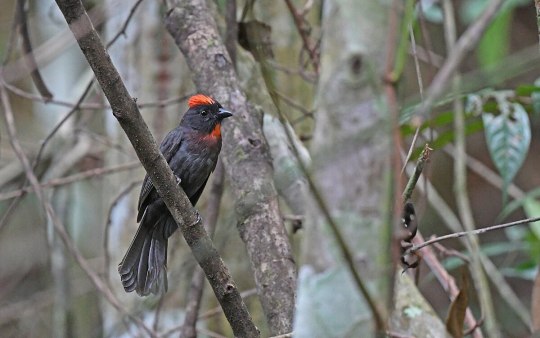#habia fuscicauda
Explore tagged Tumblr posts
Text

May 5, 2024 - Red-throated Ant-Tanager (Habia fuscicauda) These birds are found in the undergrowth of lowland forests and woodlands from southeastern Mexico through Central America to northern Colombia. They eat arthropods, fruit, and sometimes small lizards, foraging in pairs or small flocks and occasionally following swarms of army ants. Females build nests from dry leaves, moss, ferns, bark, stems, rootlets, fungus-covered twigs, and other materials in vine tangles, clumps of bamboo, saplings, and palms while males follow them, singing. They incubate the eggs and brood the chicks alone but both parents, often assisted by other adults, feed the chicks and defend the nest.
#red-throated ant-tanager#ant-tanager#habia fuscicauda#bird#birds#illustration#art#woodland#birblr art
61 notes
·
View notes
Text
Driophlox Scott et al., 2024 (new genus)

(An individual of Driophlox gutturalis, photographed by Christoph Moning, under CC BY 4.0)
Meaning of name: Driophlox = thicket flame [in Greek]
Species included: D. gutturalis (sooty ant tanager, type species, previously in Habia), D. atrimaxillaris (black-cheeked ant tanager, previously in Habia), D. cristata (crested ant tanager, previously in Habia), and D. fuscicauda (red-throated ant tanager, previously in Habia)
Age: Holocene (Meghalayan), extant
Where found: Forest undergrowth in Middle and South America
Notes: The name "ant tanager" is used for several species of tropical songbirds closely related to cardinals. Despite often being brightly colored, they are generally secretive. They feed primarily on insects and some fruits, and as their common name suggests, are known to occasionally follow swarms of army ants to capture fleeing arthropods.
Current taxonomic authorities classify all of the ant tanagers in the genus Habia. However, recent genetic studies have found that the red-crowned ant tanager (Habia rubica) is more closely related to the genus Chlorothraupis than to other ant tanagers. Given that H. rubica is the type species of Habia, a new genus is needed for the other ant tanagers, so the authors of a new paper coin the name Driophlox for this purpose.
Reference: Scott, B.F., R.T. Chesser, P. Unitt, and K.J. Burns. 2024. Driophlox, a new genus of cardinalid (Aves: Passeriformes: Cardinalidae). Zootaxa 5406: 497–500. doi: 10.11646/zootaxa.5406.3.11
41 notes
·
View notes
Photo






JUST SOME TANAGERS FROM COSTA RICA!!
Here are a series of photos taken during my last visit to Costa Rica (Jan-Feb 2019) of some Tanagers.
Despite the common name of tanagers, the pictures here are from two different families. All of them but one, belong to the Thraupidae family. Only the Ant-Tanager belongs to the Cardinalidae family.
The photos where taken along the route we followed around Tiquicia (aka Costa Rica). The places where Rancho Naturalista in Tuís de Turrialba; Bosque del Tolomuco on our way to Quizarrá de Pérez Zeledón, y Finca Pino Colina, en las Cruces de Coto Brus.
Enjoy them!!!
1 note
·
View note
Photo

🐥(Male) Red-throated Ant-Tanager🐥 📖Habia fuscicauda📖 . A neotropical bird which is a resident breeder on the Caribbean slopes from southeastern Mexico to eastern Panama.🇲🇽➡️🇵🇦😱 . Their appearance can be seen more distinguished on their throats, showing bright red color for males and yellow throats for females; both with darker cheeks🗺️🙋🏻🤔 . Love eating insects, arthropods (which will follow army ant columns) and fruits.🐛🐜🍌🍇🍓 . In Panama, Red-throated Ant-Tanagers start nesting with the first rains of the wet season and all pairs lay their first clutches within the following 6 weeks.🏞️🏕️🗺️🌎 . When the female is incubating, the paired male usually moves through their territory alone or with other group members if in a group.🐤🐤🐤 . Fun fact!! Females build the nest alone while males follow them around the territory singing. On one occasion, a male brought a dry leaf to the nest, however, the female promptly removed this item from the nest.🐣🐥♀️💪🏻 . . . #bird #trees #wing #noregrets #animal #Panama #pty #onlynature #nature #red #fauna #tree #canon #shot #pajareo #instatravel #naturephotography #wander #wild #biology #birds #america #centralamerica #tanager #eyes #calm #naturaleza #medioambiente #savetheplanet ❤️ (at Camino de Plantación) https://www.instagram.com/p/BxiMwBYnMl8/?igshid=1grmd3yalr21l
#bird#trees#wing#noregrets#animal#panama#pty#onlynature#nature#red#fauna#tree#canon#shot#pajareo#instatravel#naturephotography#wander#wild#biology#birds#america#centralamerica#tanager#eyes#calm#naturaleza#medioambiente#savetheplanet
0 notes
Photo

Red-throated Ant-Tanager / Tangara-Hormiguera Gorguirroja (Habia fuscicauda) - ♂ © Miguel Siu www.panamawildlife.net
0 notes
Photo

Red-throated Ant-Tanager / Tangara-Hormiguera Gorguirroja (Habia fuscicauda) - ♂ © Miguel "Siu" for www.panamawildlife.net
0 notes